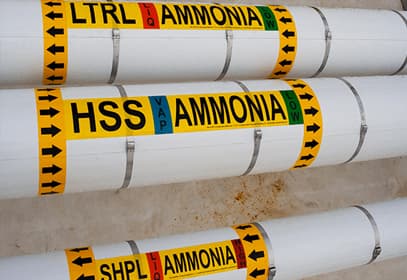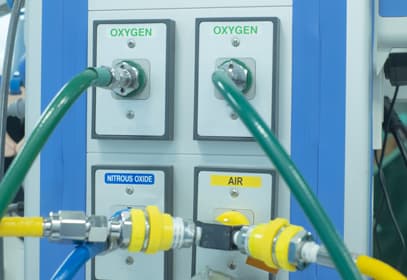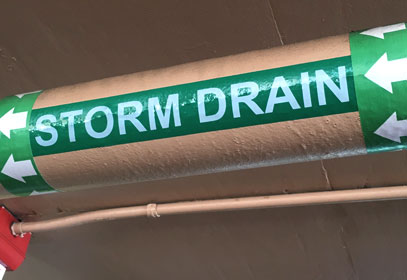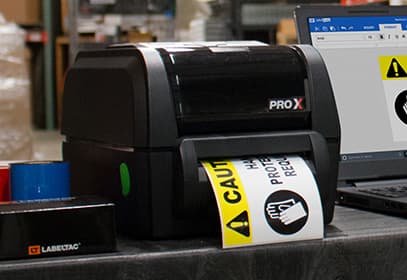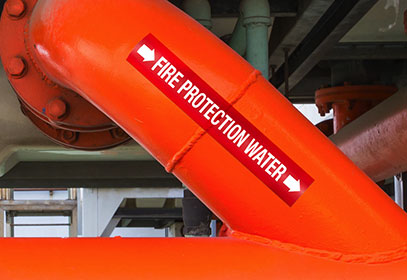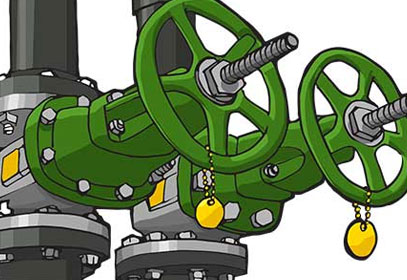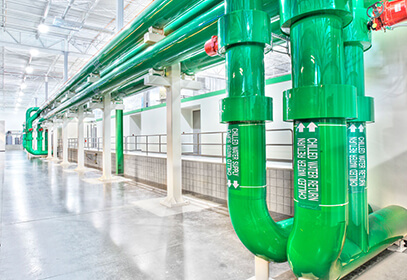Resources
Pipe Marking Articles
Beginner's Guide To Ribbon Printers
Beginner’s guide to using and maintaining ribbon printers, plus tips on choosing the right ribbon type for high-quality, long-lasting prints. …
Ammonia Pipe Marking Standards | IIAR Requirements
Because ammonia is harmful to human health any pipes carrying ammonia-based substances must have more specific labeling than those under the ANSI/ASME standards. …
Marine Pipe Marking | ISO/DIS 14726
Since marine environments are required to carry fresh water along with gases, waste media, and fire-fighting chemicals, sea-faring vessels must comply with additional pipe marking color codes. This extra effort put into pipe markings for sea-faring vessels provides workers and first responders with the information they need regarding the unique contents of those pipes. …
Medical Substance Pipe Marking | NFPA99/CGA C-9
Substances used for medical purposes have their own standards and best practices as well. Since chemical substances used in hospitals are primarily gases, which are highly flammable, the National Fire Prevention Association (NFPA) is the entity that regulates and sets safety standards. …
Water Treatment Pipe Marking
In water treatment facilities, proper pipe marking is essential for maintaining safety, efficiency, and regulatory compliance …
Your Guide to Pipe Labeling Standards
If you are looking to implement or update a pipe marking strategy for your facility it is important to gathering as much information as possible. Read More... …
A Guide to Pipe Marking Standards
For most industries, abiding by ASME/ANSI pipe marking standards is sufficient for staying safe and OSHA compliant. Some workplaces, though, are required to comply to more unique pipe marking standards due to the nature of the substance the pipes contain. …
What is a thermal printer? (direct transfer)
Thermal printers are essential to printing in an industrial setting. Learn about the two types of thermal printing to determine which one suits your facility’s needs. …
Anhydrous Ammonia – Safety & Labeling
Concentrated (or anhydrous) ammonia presents significant hazards to people and the environment. Here’s what you need to know to stay safe. …
Pipeline Labeling
Pipeline labeling is essential when using pipelines in the facility. Without the proper labeling, you are putting your employees at risk. …
Ammonia Refrigeration
When using ammonia refrigeration, or ammonia for anything in the workplace, there are a variety of OSHA regulations that need to be followed. …
ANSI Color Codes for Pipe Marking
When following the ANSI A13.1 standards, the most important thing is to understand the six most common color schemes. …
Valve Tags: Guide for Pipe Identification
Tips and recommendations for labeling the valves on your pipe system. …
Pipe Color Codes - ANSI/ASME A13.1
The ANSI/ASME A13.1 pipe marking color code explained. …
Pipe Marking Questions and Answers
What are ANSI’s Pipe Labeling Standards?
The American National Standards Institute (ANSI) is a non-profit organization that establishes and publishes standards for various industries and applications. One of the areas where ANSI has developed standards is pipe labeling. ANSI's pipe labeling standards provide a consistent and standardized system for identifying pipes, valves, and other equipment throughout a facility. This helps to… …
What is the Difference Between Piping and a Pipeline?
Piping and pipeline are two commonly used terms in the oil and gas, construction, and manufacturing industries, but they have distinct meanings. Understanding the difference between the two is essential for correctly identifying and designing systems for the transport of liquids, gases, and other materials. Piping generally refers to the system of pipes and components used… …
What is the difference between pipe markers and the NFPA diamond?
While NFPA diamonds and pipe markers work to inform employees to be cautious around highly dangerous or hazardous substances, there are a few very distinct differences between the two visual communicators. However, let’s begin with the similarities. Both the NFPA diamonds and pipe markers share the following: They both use colors as a primary source… …
How do you label water pipes?
Pipes that contain any type of water should be labeled green as per the ANSI/ASME A13.1 standard. This can include boiler water, potable water, waste water, etc. Labeling pipes that contain water is just as important as labeling those that contain hazardous chemicals. The reason being because just like those hazardous chemicals, water can also… …
How do you label pipes?
Labeling pipes is easy as long as the user has the right tools. The first of those tools is gathering information. Every employer and their employees should be familiar with the appropriate pipe labeling standards for their facility’s needs. These can be any of the following standards: ANSI/ASME A13.1 Pipe Marking Standard NFPA 99/CGA C-9… …
What color code is used for a piping system conveying gaseous elements?
If a facility only has the need for using the ANSI/ASME A13.1 standard, then normal gaseous materials should follow that standard. However, gas mixtures or those that are being used for medical purposes must follow the NFPA 99/CGA C-9 pipe marking standards. It may seem surprising but there are quite a few other pipe marking… …
What is a pipe marker?
A pipe marker is a form of visual communication that primarily uses an adhesive vinyl tape to label substances being transported via pipes throughout the warehouse. Pipe markers are an incredibly important aspect of visual communication, especially for those performing tasks or maintenance on pipes. While performing maintenance, it is essential that workers know exactly what… …
Is there a color code for pipelines?
identifiers as pipe markers or pipe labels. Easy to procure and made to last for a long time, pipeline markers are an excellent visual tool to apply to facilities needing more clarity in the realm of hazardous chemical identification. Aside from being a good tool to improve workplace safety, pipe markers are actually required by… …
What does a blue pipe label mean?
Blue pipe labels are associated with compressed air, and in some cases compressed steam. Sticking to the ANSI/ASME A13.1 pipe marking standard is essential to not only stay in compliance with OSHA but to also keep employees safe from the hazards that are contained in piping systems. Working around compressed air requires employee training and an… …
What color are steam pipes?
Pipes that contain steam can be tricky to identify as there are two potential solutions: Green is used for cooling, boilers, drinking, and other forms of water being transported through a facility. Blue is needed for compressed air normally. However, compressed steam does also fall under this category. Steam pipes pose a unique danger to employees… …
Does OSHA require pipe labeling?
Pipe labeling is essential for every facility that contains pipes, no matter if the pipe just contains potable water or if it contains hazardous chemicals such as anhydrous ammonia. Simply stating that pipe marking “should” be done in these kinds of facilities is often not enough. For that reason, OSHA does require and enforce the… …
what does a yellow pipe label mean?
The color of a pipe label is one of the most important aspects of pipe identification. The reason being because color has the ability to be seen from a far distance rather than text or symbols that require employees or visitors to approach the pipe to be able to identify its contents. With that being… …
What are pipe labeling standards for sea vessels and marine environments?
Operating on offshore platforms, sea vessels, or other marine areas is significantly different than working on normal land. It is so different, in fact, that many of the safety and efficiency standards that are in place for land-based facilities have to be changed in order to meet the needs of working on or near the… …
What are different materials you can use for pipe labels?
One of the most important decisions to make when implementing a pipe labeling strategy is what type of label stock to use. In most cases, any standard label stock will work just fine for marking pipes. You do, however, need to consider several things before making a final decision. Things to Think About When deciding what type… …
How do I clean pipe labels?
Once you have all your pipe marking labels in place it will be easy for those working with, or around, the pipes to learn what is contained within. This will help to improve safety, make working on the pipes easier, and offer a variety of other benefits as well. Over time, however, the labels can… …
Can I create custom pipe labels and still be compliant?
If you are looking to label the pipes in your facility, you will want to make sure you are compliant with the ANSI/ASME standards that are in place. While these standards aren’t strictly required by OSHA in the traditional sense, they are what is widely recognized as best practices. In addition, OSHA does indirectly require… …
Does pipe marking affect efficiency?
When companies look at pipe marking strategies, they often start by reviewing how these markings can improve the safety of a company. While pipe markings certainly do help to improve workplace safety, that is just the beginning of the benefits that they offer. A good pipe marking strategy will also help to boost the efficiency of… …
What are the ANSI standards for pipe color codes?
The American National Standards Institute, or ANSI, is a private organization that creates and publishes standards for a wide range of different products, services, systems, and personnel. One of the sets of standards that they have had in place for many years is focused on pipe markings and labeling. Pipe labels are used primarily in commercial… …
What information can I include on a pipe label?
When labeling pipes you will have a lot of options available in terms of what exactly goes on the labels. This is because OSHA typically doesn’t regulate exactly how the labels should look, or what should be on them (though they do offer recommendations). For most facilities, pipe markings will still be a good idea… …
How do I calculate how many pipe labels I will need?
When adding labels to your pipes it can be difficult to estimate how many of each type of label you will need. Understanding the requirements of where the labels need to go is a great start. From there, you can get a good idea of how many labels will be necessary. For many companies, however, it… …
What text should I use on a pipe label?
Pipe labels are quite a bit different than most other types of labels in the workplace. This is partly because of the fact that there is a very limited amount of visible room on this particular type of label. Since the label has to wrap around the pipe, it requires you to ensure placement of… …
What symbols should be put on a pipe label?
When labeling pipes in the workplace it is important to be able to convey as much information as possible with a limited amount of space. There are a variety of strategies used to accomplish this goal including using set color combinations, the right size of text, and even using symbols. The symbols used on pipe… …
What should the height of text on a pipe label be?
When using labels in the workplace to convey information it is important to ensure everything is readable from as great a distance as possible. For many things this simply means printing the label with text in a large font so that people can see it from quite some distance away. When labeling pipes, however, that… …
What do user-defined color combos mean for pipe marking?
When labeling pipes in the workplace most companies will follow the ANSI recommended pipe color codes. This will help ensure everyone who needs to see the labels will know what is within them and how to work with them very quickly. While there are quite a few set color combinations in place, ANSI has also… …
Where should I place pipe labels?
One of the most important decisions to make when starting a pipe marking strategy is where to place the labels. Proper positioning will ensure that people can see them, and that they will be able to provide the right information to those in the area. The best place to start when working on this is… …
What are different types of pipe labels?
When working to label the pipes in your facility you will want to start out by making a plan that is in line with the ANSI/ASME standards. This will help you to determine what will go on the labels, where they will be placed, and much more. Once this has been determined, you need to… …
What is the ASME standard for pipe marking?
Pipe markings are used in a wide range of environments including commercial, industrial, and even residential. They are also used in structures around the world. These markings are an easy and affordable way to ensure those who need to know what is contained within a pipe can identify it right away. In order to make… …
What are the different standards of pipe marking?
When it comes to pipe markings in the workplace, there is really one major set of standards that is used in virtually all locations. This set of standards has been developed by ANSI/ASME, and is what is recommended by OSHA. The standards are updated as needed when there are changes to technologies or systems associated… …
Is pipe labeling required by law?
To answer the question of whether pipe labeling is required by law, the simplest reply is yes, they are required. The way they are required, however, is a little different than most other workplace safety regulations, and it is important to understand this in order to remain in compliance. As with most safety regulations like this,… …
Does OSHA regulate pipe marking?
This is an interesting question, and not quite as straight forward as it would seem. OSHA hasn’t ever come up with their own set of pipe marking or labeling requirements that they require companies to follow. That being said, however, they have included pipe marking requirements in their General Duty Clause. The General Duty Clause… …
Why is pipe labeling important?
Marking or labeling the pipes in a facility is a very important, but sometimes overlooked, effort. There are many reasons why a company should ensure their pipes are properly marked throughout their facility, and the markings kept in good readable condition. The following are some of the many reasons why pipe labeling is important. OSHA Labeling… …
What is pipe labeling/pipe marking?
Pipe labeling, also commonly called pipe marking, is a common practice in most buildings and many other environments around the world. To put it simply, it is any effort that is made to label or mark pipes to provide information about the pipe, including the contents of the pipes, to those in the area. While… …

